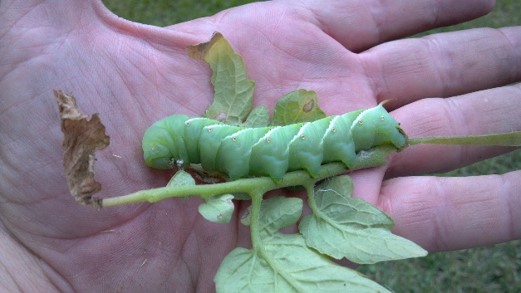Tobacco hornworm (Manduca sexta) care
The tobacco hornworm is the caterpillar stage of the five-spotted hawk moth (Manduca sexta). They constitute a major pest of nightshade (solanaceae) crop plants, such as tobacco, tomato, and eggplant. Tobacco hornworms are often used in classrooms to demonstrate the process of lepidopteran metamorphosis. However, much tobacco hornworm research focuses on assessing pest control methods.- 5th instar tobacco hornworm caterpillar:

- Image via Wikimedia Commons
Rearing and Caring for Tobacco Hornworms
Feed
Tobacco hornworms have a flexible diet, with the ability to feed on the following:- Artificial chow (pre-prepared): Tobacco hornworm chow can be obtained from online sellers such as Amazon. Once obtained, refrigerate and handle under sterile conditions. Cubes may be cut out of the pre-prepared chow, or the chow may be re-liquified by adding 15 mL of sterile water to 6+ g of chow and microwaving at 100% power for 40 seconds.
- Artificial chow (powder): Tobacco hornworm chow powder can be obtained from online sellers such as Amazon. It may be stored at room temperature. To prepare, mix 80.6 mL sterile water with 19.4 g of chow powder and heat for 2 - 3 minutes in a microwave on 40% power. Pour into a container and let solidify at room temperature or cooler.
- Leaves of natural host plants: Not all solanaceae plants are edible to tobacco hornworms. See Jones et al. 1985 for mortality rates on different plants in the nicotina genus. Never provide wilted leaves.
- Note: Caterpillars may only switch between artificial and leaf diets during their early larval stages.
Container Construction
When designing tobacco hornworms containers, consider the following:- Air: Manduca sexta caterpillars require air holes in their containment chambers. Three or four holes poked with thumb-tacks is sufficient.
- Containment: Manduca sexta caterpillars may escape through small holes if they are not covered by mesh. Additionally, they may chew through plastic films such as parafilm or shrink wrap. They are also excellent climbers and capable of holding onto vertical surfaces or the ceiling of their containers.
- Moisture: Manduca sexta caterpillars may receive all necessary moisture from their feed if they are fed regularly. Some classroom guides recommend including damp paper towels in containers, but this may lead to mold infection. Dessicated caterpillars take on a brownish and shrunken appearance.
- Food: Manduca sexta caterpillars grow rapidly and require a steady source of food, though the amount will depend on their current size. A cubic centimeter of diet or single leaf each day should be enough to sustain five second-instar larvae.
- Warmth: Manduca sexta caterpillars can be reared at room temperature, but 30 degrees celsius is ideal. Cooler temperatures will hinder their growth and delay hatching.
- Example Container: A sterile, medium-sized, clear plastic solo cup, perforated several times with thumb-tacks and covered with mesh.
Handling and Transfer
Tobacco hornworms begin life very small and fragile, but grow to the size of a finger before entering the pupal stage. To handle them when small or large, use the following methods:- Note: Caterpillars should always be set down gently. They should be set directly onto food as often as possible.
- Straw: To transfer young and fragile caterpillars (first and second instar), attach mesh to the end of a hollow plastic tube. Fit a disposable plastic micropipette tip over the end with the mesh. Suck air through the other end, pointing the micropipette tip at a caterpillar's posterior. This will break the caterpillar's grip. Peel the hornworm off of a surface from posterior to anterior and then transport to the desired location. Regularly replace the pipette tip and sterilize the end of the straw coming into contact with human saliva.
- Tweezers: Tobacco hornworm larvae have sensitive bodies, but they can be picked up by their distinctive tail horns with a pair of tweezers. Limit this to older instars (third and beyond).
- Hands: Larvae may be gently picked up and transported with a gloved hand. However, thus may be too forceful in first or second instar larvae, and the caterpillar's silk may make it difficult to put back down.
Preventative Healthcare
While tobacco hornworms reared in classrooms are often raised in bulk with very little maintenance, this may lead to disease and higher mortality rates. For optimal caterpillar survival rates:- Bleach tobacco hornworm eggs before placing them in their containers. Submerge in 10% bleach for one minute.
- Limit the number of caterpillars per container. They cannibalize each other even when plenty of alternative food is available. No more than five caterpillars per containers is prudent, and fewer is preferable.
- Transfer caterpillars into new containers daily, or clean containers daily: ethanol is not necessary unless disease is obvious, but hornworm frass (faeces) and old food must be removed.
- Provide fresh food for caterpillars daily.
| I | Attachment | History | Action | Size | Date | Who | Comment |
|---|---|---|---|---|---|---|---|
| |
manduca_sexta.jpg | r1 | manage | 39.2 K | 2020-04-08 - 23:24 | ElizabethRobinson | 5th instar tobacco hornworm caterpillar |
Barrick Lab > ProtocolList > ProtocolsHornwormCare
Topic revision: r2 - 2020-04-11 - 01:49:00 - Main.ElizabethRobinson

